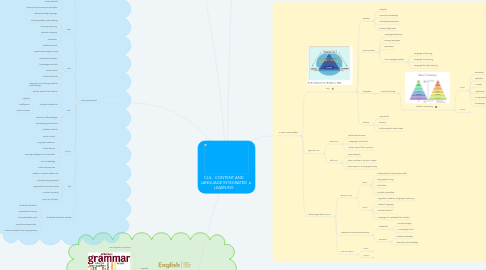
1. ELT & CLIL
1.1. ELT
1.1.1. Linguistic
1.1.1.1. non-linguistic curriculum
1.1.1.2. To study grammar
1.1.1.3. Listen, read, grammar, write and speak
1.2. CLIL
1.2.1. Linked linguistic
1.2.1.1. Language proficiency exams
1.2.1.2. Practices grammar
1.2.1.3. Integrates communicative skills
2. Perspectives
2.1. Other approaches
2.1.1. CLT
2.1.1.1. Communication
2.1.1.2. Comunicative goals
2.1.1.3. Meaningful learning
2.1.1.4. Real world contexts
2.1.1.5. Teacher as facilitator
2.1.1.6. Active students
2.1.1.7. Fluency and accuaracy as principles
2.1.2. TBLT
2.1.2.1. Tasks promoting language
2.1.2.2. Solving problem methodology
2.1.2.3. Meaning is primary
2.1.2.4. Defined outcomes
2.1.2.5. Interaction
2.1.2.6. Student centred
2.1.3. PBT
2.1.3.1. Projects promoting learning
2.1.3.2. Real-world problems
2.1.3.3. knowledge and skills
2.1.3.4. Final product
2.1.3.5. Student centered
2.1.3.6. Coperative and solving problems methodology
2.1.4. ESP
2.1.4.1. Specific needs of the learner
2.1.4.2. Content centered on
2.1.4.2.1. Subjects
2.1.4.2.2. Proffessions
2.1.4.2.3. Social activities
2.1.4.3. Particular methodologies
2.1.4.4. Developing specific skills
2.1.4.5. Authenty contects
2.1.5. CALLA
2.1.5.1. Social context
2.1.5.2. Language awarness
2.1.5.3. Critical literacy
2.1.5.4. Learning strategies and study skills
2.1.5.5. Prior knowledge
2.1.5.6. Cultural expiriences
2.1.6. CBI
2.1.6.1. Based on subject-matter core
2.1.6.2. Authentic language texts
2.1.6.3. Appropriate to specific needs
2.1.6.4. Content is priority
2.1.6.5. Focus on life skills
2.1.7. Sheltered instruction models
2.1.7.1. Students interaction
2.1.7.2. Cooperative learning
2.1.7.3. Comprehensible input
2.1.7.4. Formative assessments
2.1.7.5. Clear and explicit learning objectives
3. SIOP & CLIL
3.1. SIOP
3.1.1. Academic content understandable
3.1.2. Components
3.1.2.1. Preparation
3.1.2.2. Building background
3.1.2.3. Comprehensible input
3.1.2.4. Strategies
3.1.2.5. Interaction
3.1.2.6. Practice/application
3.1.2.7. Lesson delivery
3.1.2.8. Review and assessment
3.1.3. Lesson planning guiding
4. Main concepts
4.1. 4CS
4.1.1. Content
4.1.1.1. Subjects
4.1.1.2. Curricular knowledge
4.1.1.3. Interdisciplinary topics
4.1.1.4. Content objectives
4.1.2. Comunication
4.1.2.1. Language objectives
4.1.2.2. Foreing language
4.1.2.3. Expression
4.1.2.4. The Language triptych
4.1.2.4.1. Language of learning
4.1.2.4.2. Language for learning
4.1.2.4.3. Language through learning
4.1.3. Cognition
4.1.3.1. Level of learning
4.1.3.1.1. Bloom's Taxonomy
4.1.4. Culture
4.1.4.1. Ways of life
4.1.4.2. Literacy
4.1.4.3. Culture-specific world views
4.2. Types of CLIL
4.2.1. Hard CLIL
4.2.1.1. Deliver whole areas
4.2.1.2. Language and content
4.2.1.3. About 50% of the curriculum
4.2.2. Soft CLIL
4.2.2.1. Some subjects
4.2.2.2. Some minutes or hours in a week
4.2.2.3. Some topics in a language course
4.3. The biilingual brain in CLIL
4.3.1. BICS & CALP
4.3.1.1. BICS
4.3.1.1.1. Interpersonal communication skills
4.3.1.1.2. Language for living
4.3.1.1.3. Interaction
4.3.1.1.4. Context embedded
4.3.1.2. CALP
4.3.1.2.1. Cognitive Academic Language Proficiency
4.3.1.2.2. Abstract language
4.3.1.2.3. Context reduced
4.3.1.2.4. Language to understand the content
4.3.2. Separate & Common proficiency
4.3.2.1. Seaparate
4.3.2.1.1. Limited storage
4.3.2.1.2. Monolingual mind
4.3.2.2. Common
4.3.2.2.1. Linked Knowledge
4.3.2.2.2. Interaction of knowledge
4.3.3. LOTS & HOTS
4.3.3.1. LOTS
4.3.3.1.1. Evaluation
4.3.3.1.2. Synthesis
4.3.3.1.3. Analysis
4.3.3.1.4. Application
4.3.3.1.5. Comprehension
4.3.3.1.6. Knowledge
4.3.3.2. HOTS
4.3.3.2.1. Creating
4.3.3.2.2. Evaluating
4.3.3.2.3. Analysing
4.3.3.2.4. Applying
4.3.3.2.5. Understanding
4.3.3.2.6. Remembering
5. About it?
5.1. Approach to teaching and learning languages
5.1.1. Content
5.1.1.1. Science
5.1.1.2. Social studies
5.1.1.3. Literature
5.1.1.4. Math
5.1.1.5. Among others
5.1.2. language
5.1.2.1. English
